Are you curious about oyster mushrooms? Maybe you want to try to find some wild growing oyster mushrooms in your area.
Or maybe you just want to know what they taste like before you decide to buy a pack of them from the supermarket.
This article is intended to be a complete guide to oyster mushrooms. By the time you’re done reading it, all of your answers about oyster mushrooms will be answered!
What Are Oyster Mushrooms?
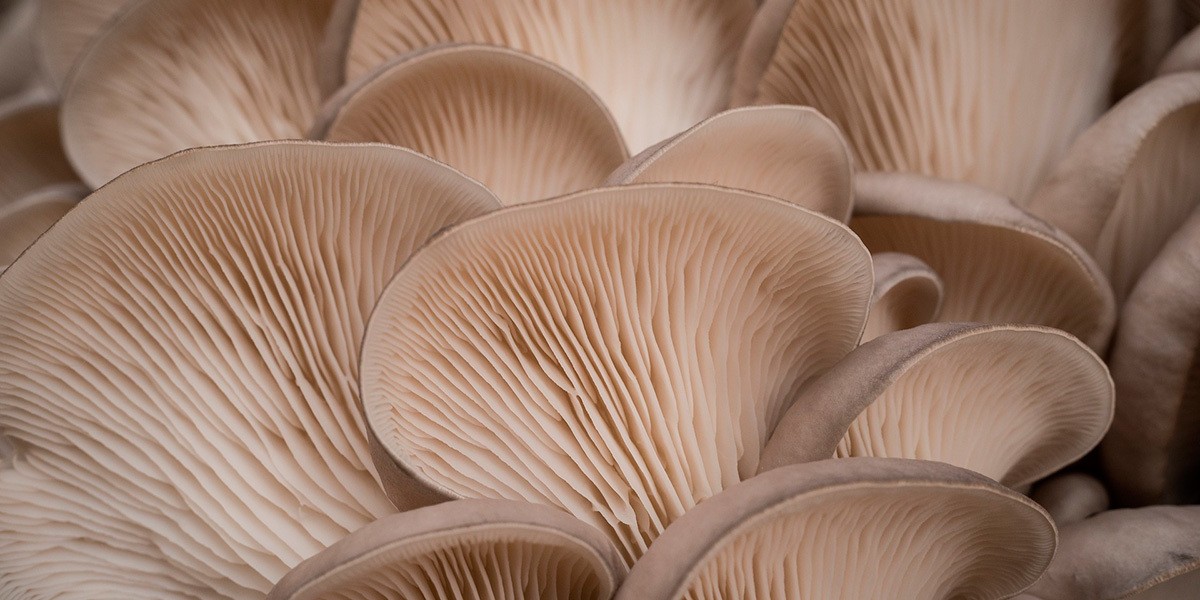
Oyster mushrooms are a type of edible fungi. They are one of the most widely consumed mushrooms in the world. They get their name from their oyster-shaped cap and very short (or completely absent) stem.
They’re also similar to the color of raw oysters. Oyster mushrooms are typically a light grey or greyish-brown color.
However, they come in several other colors including yellow and pink! They are one of the easiest types of mushrooms to grow, due to their fast growth, wide variety of potential substrates and tolerance to growing conditions.
Interested to see an Oyster mushroom farm in action? Check out this short tour inside our low tech mushroom farm:
What Do Oyster Mushrooms Taste Like?
When cooked, oyster mushrooms have a smooth oyster-like texture and some say a slight hint of seafood flavor. This may also contribute to their name.
It’s not uncommon for people to also describe oyster mushrooms as having a subtle anise flavor.
Both flavors are very subtle though, and are usually undetectable once the mushrooms are incorporated into a dish. Overall they have a very mild flavor with a slight earthy note.
When Are Oyster Mushrooms In Season?
In the wild, you can find oyster mushrooms in the fall. The best time is after the first frost of the year, or after other big weather changes like the first hot weekend of spring.
Commercial growers are harvesting oyster mushrooms all year round, so they’re always available as long as your supermarket is stocking them.
Most oyster mushrooms are grown indoors under controlled conditions, so there is no good or bad season as with some other crops.
Where Can I Find Wild Oyster Mushrooms?
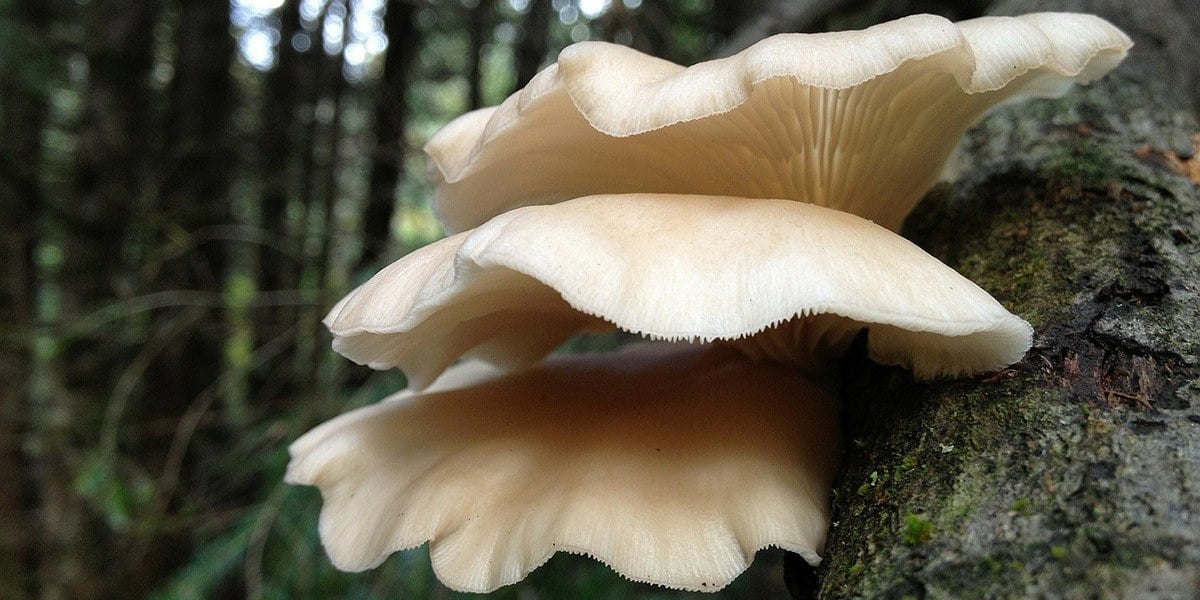
In nature, oyster mushrooms form clusters called shelves on rotting or fallen logs. So if you find one, you’ll often find a whole bunch close together.
Cultivated oyster mushrooms tend to grow more individually, but will still often form large clusters.
Look for logs, fallen trees, or dead standing trees as potential homes for oyster mushrooms. Be sure to check underneath trees that have fallen over as well, as oysters often prefer to grow in the shade.
They tend to particularly like growing on oak and beech trees in old, leafy, open forests.
Oyster mushrooms grow very quickly. You’ll need to find them while they’re still young or they could be quite leathery and not worth eating.
Different Types Of Oyster Mushrooms
1) Pearl Oyster (Pleurotus ostreatus)
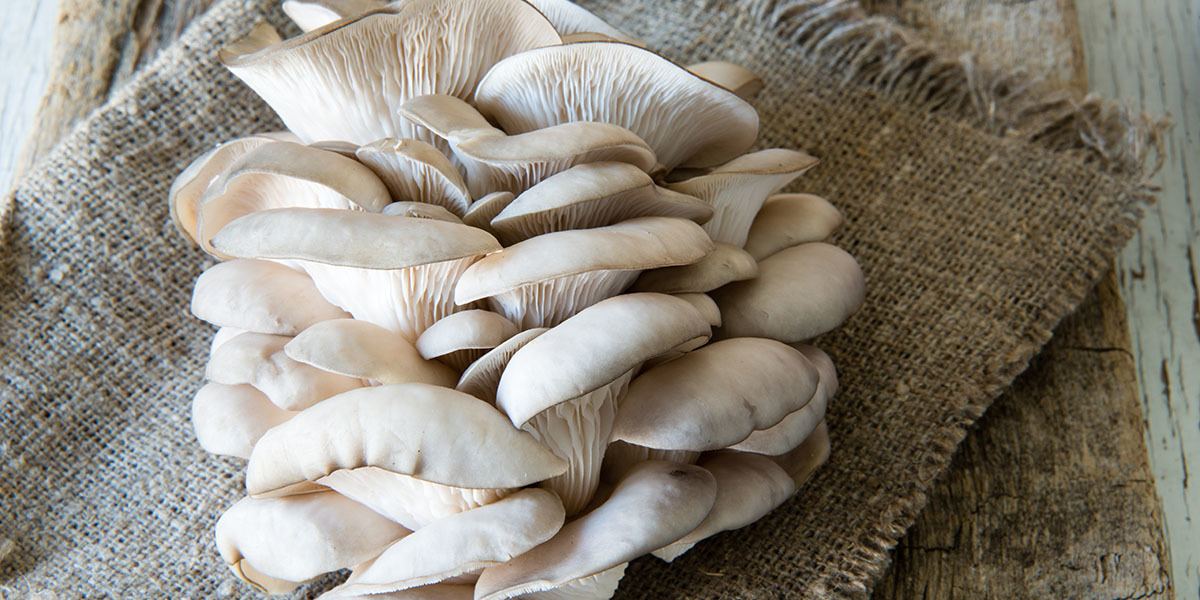
Pearl oysters are the most common type of oyster mushroom, particularly in North America.
Pearl oyster mushrooms have a slightly sweet and woodsy taste, but they’re more mild and tender than a shiitake mushroom.
2) Blue Oyster (Pleurotus ostreatus var. columbinus)
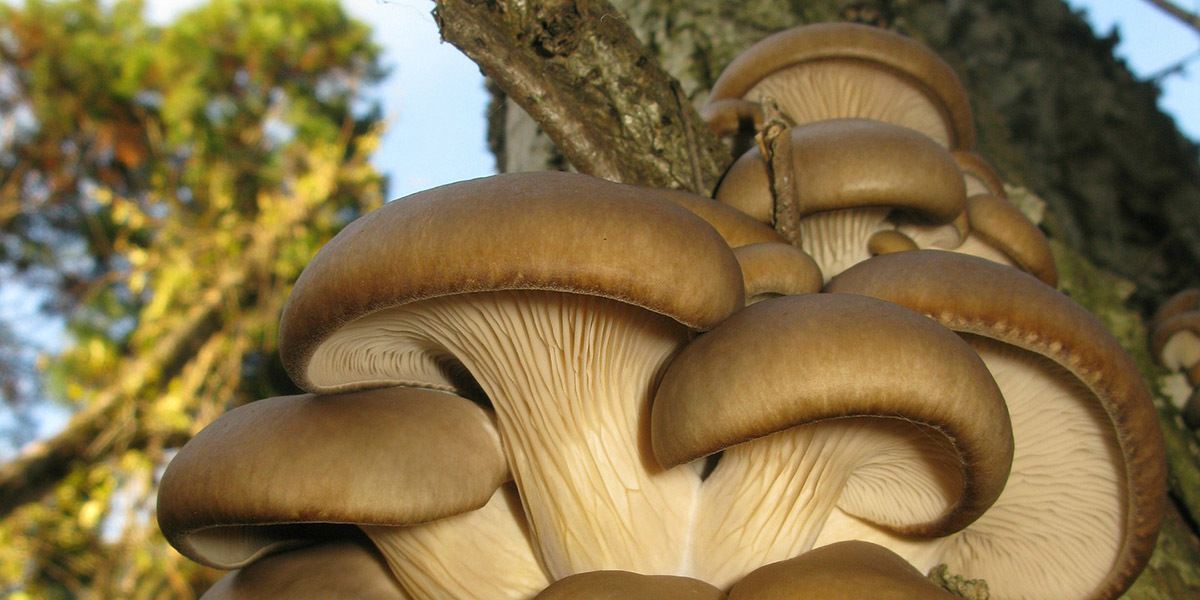
Unlike the vibrant golden and pink oysters, blue oysters aren’t a bright blue hue as you might expect. They’re grey with a slight blueish hue.
They have dark caps and pale gills, and the contrast can give a nice appearance.
Aside from looks, blue oysters taste identical to pearl oysters.
3) Golden Oyster (Pleurotus citrinopileatus)
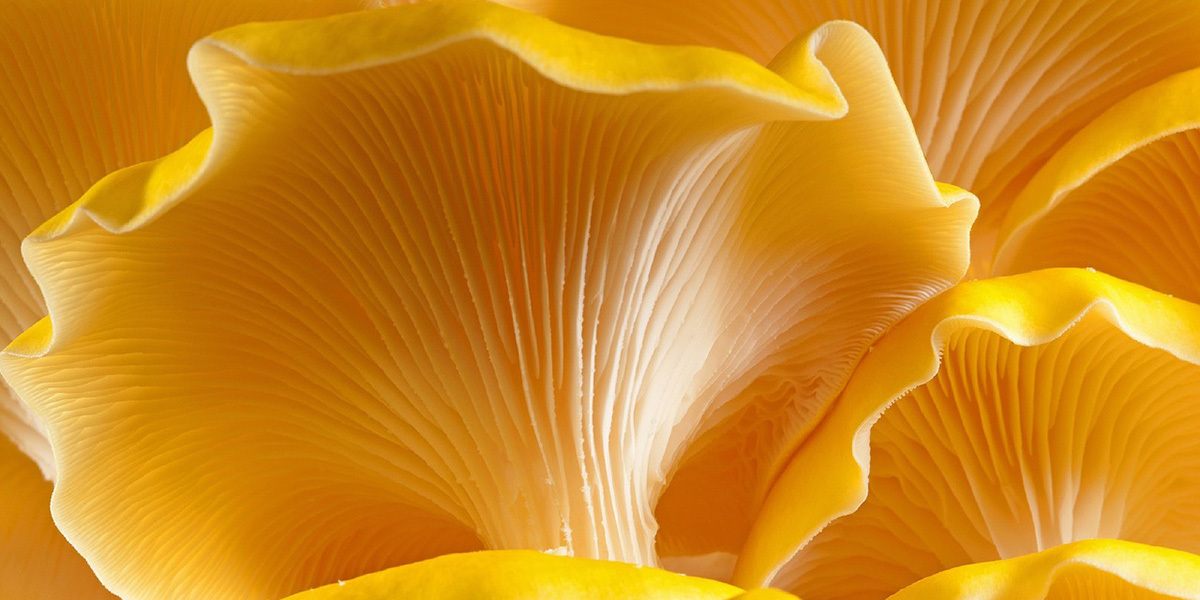
As you’d expect, golden oysters are a bright yellow color. They have a more complex and aromatic flavor than the standard pearl oyster.
4) Pink Oyster (Pleurotus salmoneo stramineus)
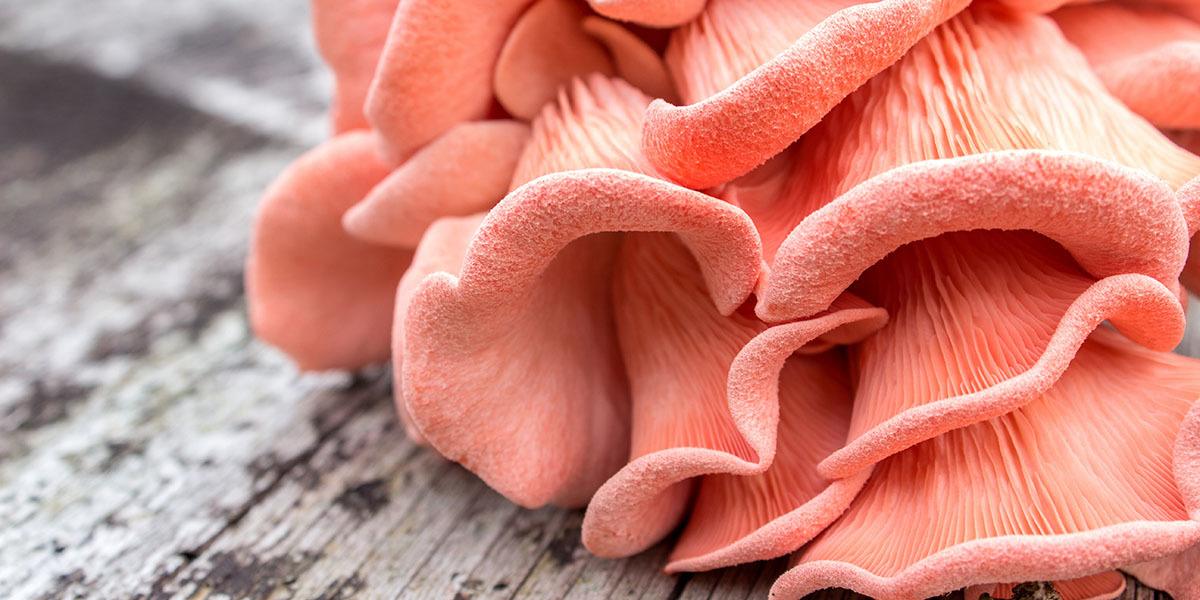
Pink oysters have a bright pink color and more ruffled appearance. Unfortunately, the vibrant color fades when it is cooked. These oysters tend to be more woody and tough, and also more pungent.
5) Phoenix Oyster (Pleurotus pulmonarius)
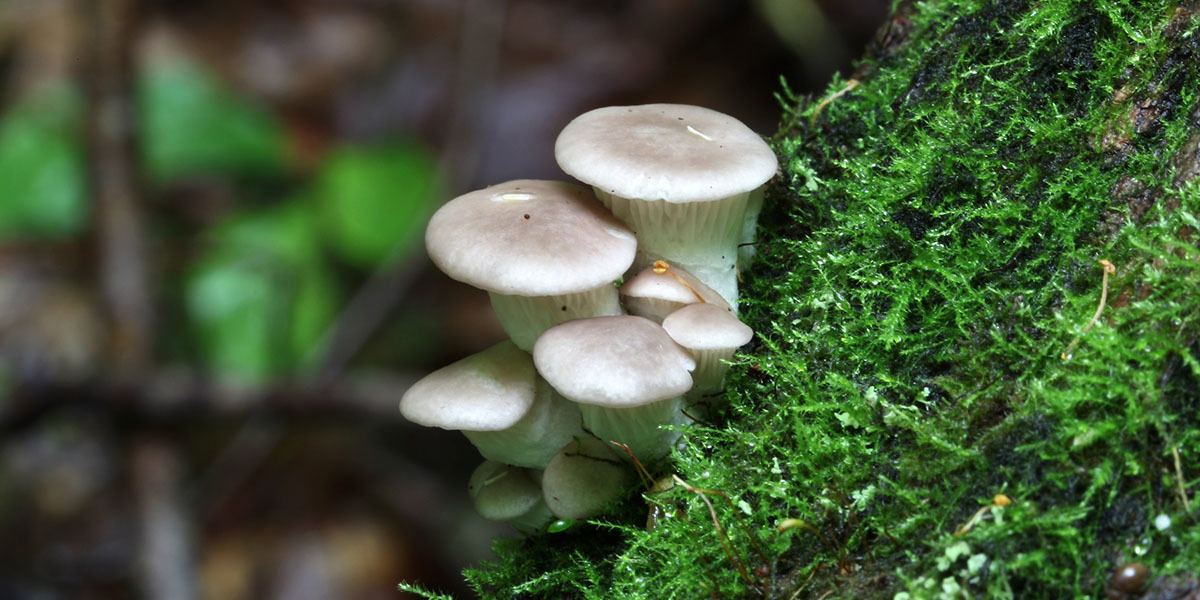
The phoenix oyster mushroom is very similar in appearance to the pearl oyster, except its caps are usually smaller and paler in color, and it often grows a longer stem. It also prefers warmer weather and tends to grow in late summer.
Otherwise, the two taste pretty much the same.
6) King Oyster (Pleurotus eryngii)
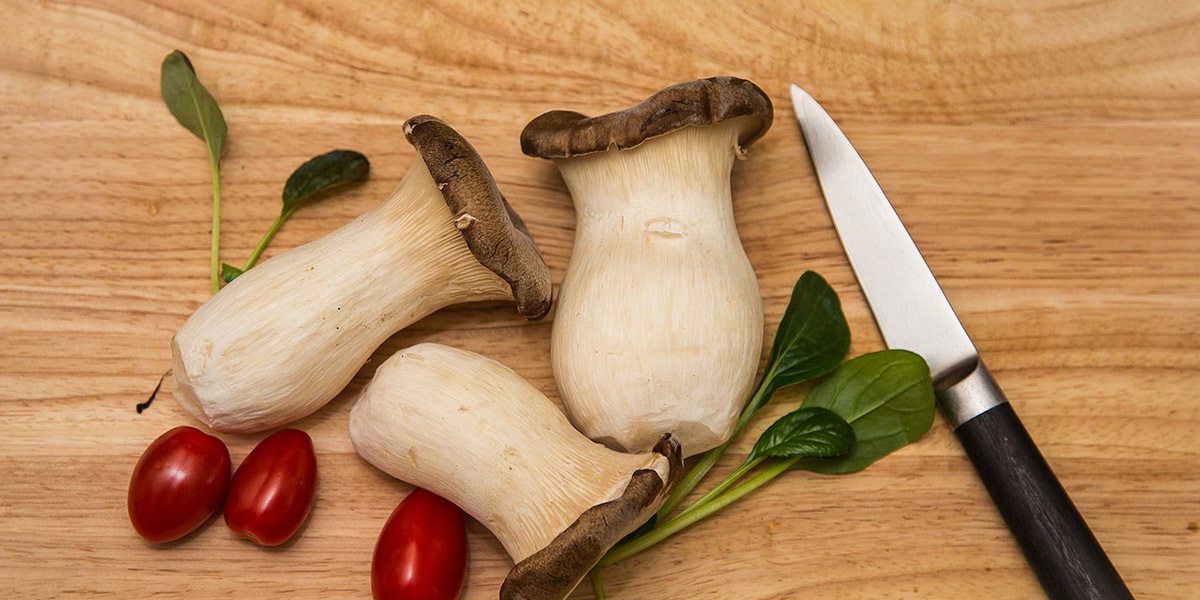
The king oyster is the largest of all the oyster mushrooms, and they look very different than other pleurotus mushrooms. They grow individually with thick and meaty white stems and tan-colored caps.
It’s found natively in the Mediterranean, Middle East, Northern Africa, and Asia.
How To Identify Oyster Mushrooms
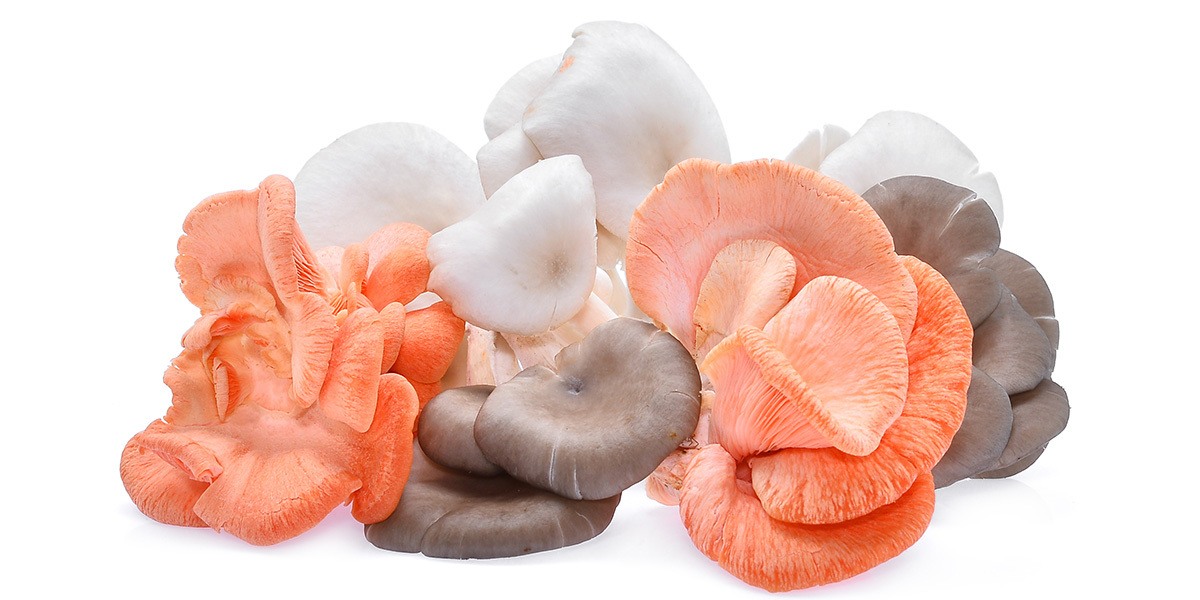
There are other mushrooms that could look similar to an oyster mushroom for a novice, so take as many precautions as possible to be sure you’ve positively identified your mushrooms before eating them. If you aren’t 100% sure, don’t eat it!
Ask an expert if you know anyone with experience hunting mushrooms.
1. The Cap
The first thing to look for when identifying an oyster mushroom is its oyster-shaped cap.
It should be oyster or fan shaped. Most oyster mushrooms are 5 to 25 cm in size (2 to 10 inches across.) They should be smooth with no scales or warts.
The flesh of an oyster mushroom is firm and white, and usually light white to brown on top.
Oyster mushrooms often grow in a shelf-like formation with overlapping clusters.
2. Gills
Oyster mushrooms have decurrent gills. This means they’re attached to the stem and run most of the way down it. Most oyster mushrooms have white gills.
3. Stem
Most oyster mushrooms don’t have a stem at all. If they do have a stem, it will be quite short and stubby and usually growing off-center.
Oyster mushrooms growing on top of a log may have a more well-developed stem compared to those growing on the side.
There is no sack around the base of the stem, nor a rim around it.
4. Spore Print
Test your oyster mushrooms for spore prints on a dark background. The spore print should be white, or possibly a lilac-gray color.
5. Where Is It Growing?
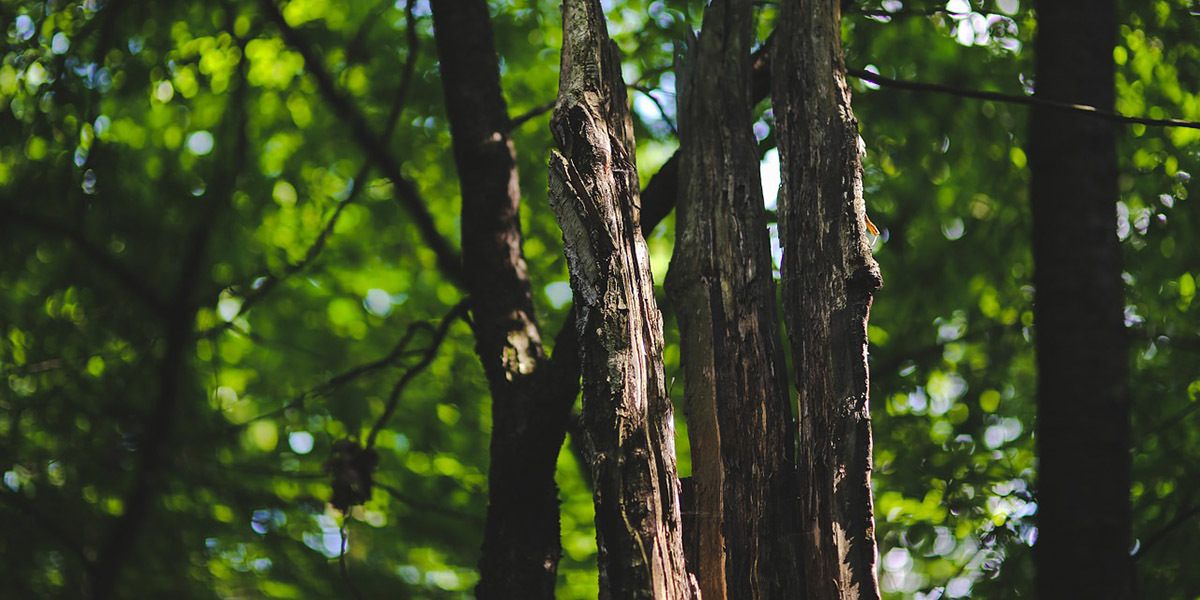
Oyster mushrooms are saprotrophic, which means they feed on dead material.
If they’re growing on sick or dying trees or dead logs, that’s a good sign. If you see what you think are oyster mushrooms growing on healthy trees, I would be cautious.
Oyster mushrooms prefer deciduous hardwood trees like aspen or beech. But they will sometimes grow on coniferous trees too.
6. Smell
Some people say that oyster mushrooms smell slightly like black licorice or anise.
Oyster Mushroom Lookalikes
There are several different types of pleurotus or oyster mushrooms. All true oyster mushrooms are edible. So if you mistake one for the other, it’s not a big deal.
However, there are also some lookalikes to avoid.
1) Elm Oyster

One lookalike is the elm oyster. It’s not actually an oyster mushroom at all, but it can be easily misidentified as one.
The easiest way to tell an elm oyster is by looking at its gills. An elm oyster’s gills don’t run down the stem like a true oyster. The gills stop suddenly at the base of the stem.
Elm oysters aren’t poisonous and are actually edible, although most people agree they aren’t as tasty as a real oyster mushroom.
3) Omphalotus nidiformis AKA Ghost Fungus
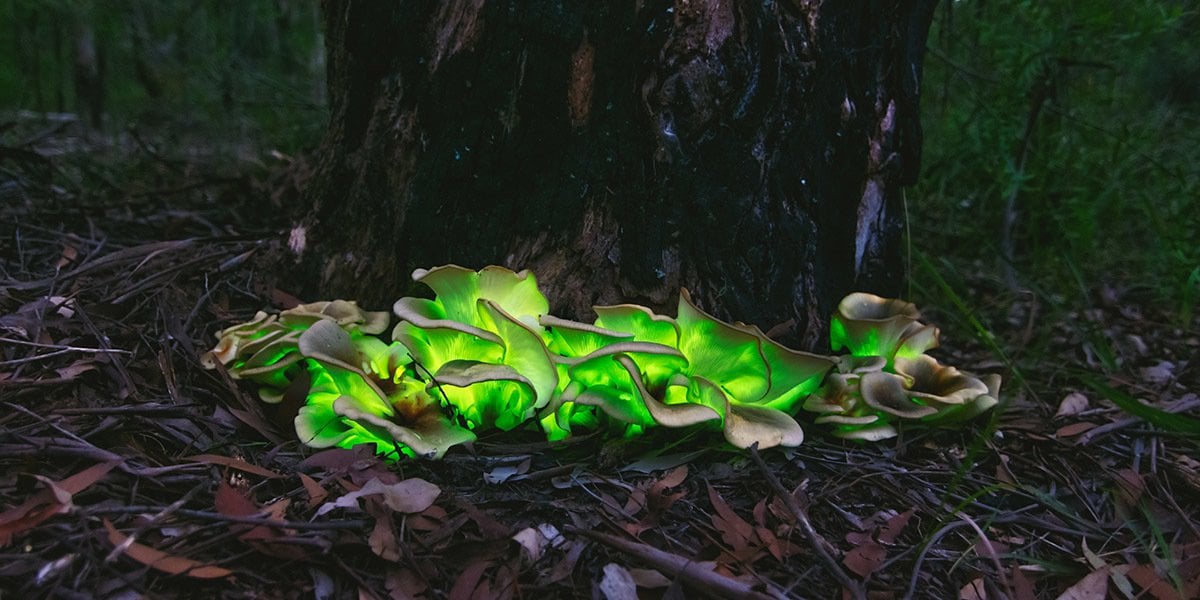
This oyster lookalike only grows in Australia and Japan. So in North America and Europe you don’t need to worry about them. If you live in one of those countries however, you should familiarize yourself with the differences.
An easy way to tell is because Omphalotus nidiformis is bioluminescent – it glows in the dark! Which is where the mushroom gets its nickname of “ghost fungus”.
3) Omphalotus olearius AKA Jack-O-Lantern Mushroom
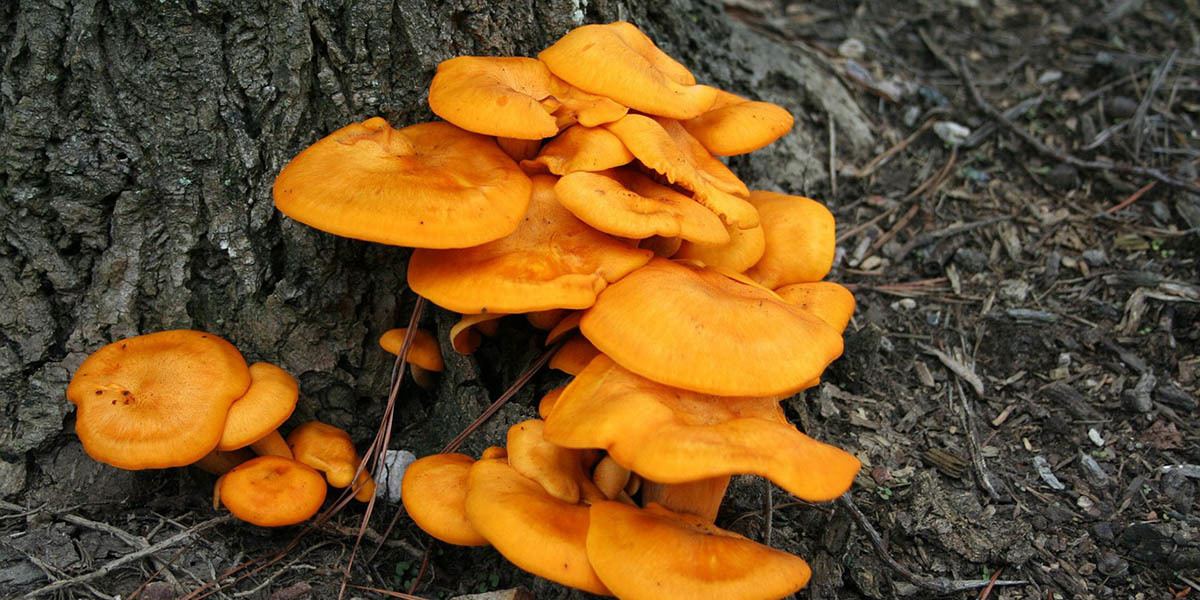
This mushroom is commonly known as the jack-o-lantern mushroom. Much like the ghost fungus, it has bioluminescent properties.
This mushroom is found in Europe, and similar Omphalotus mushrooms are also found in California, Mexico, and other parts of North America.
This mushroom is an orange color and will cause severe nausea, cramping, and diarrhea if eaten. For this reason I’d avoid any suspected oyster mushrooms that are orange in color.
4) Clitocybe dealbata AKA Ivory Funnel
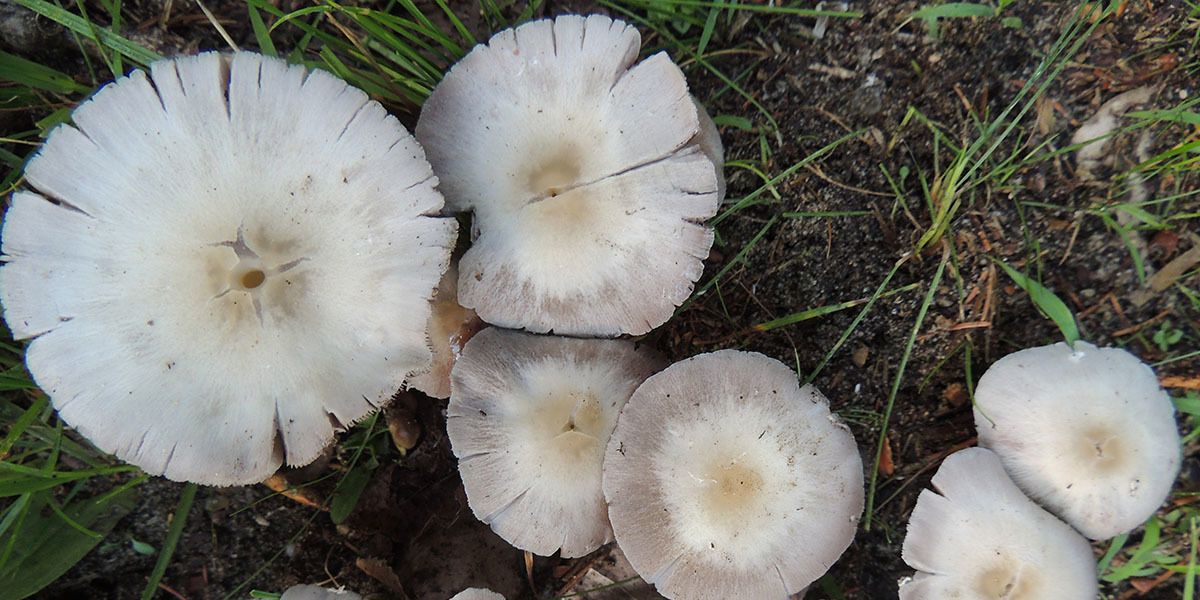
This mushroom grows in grassy areas like meadows, but it has gills that resemble an oyster mushroom. So if they were growing near dead logs, you might potentially think they were oysters.
These mushrooms are also nicknamed the sweating mushroom because the toxin called muscarine they contain starts causing sweating, salivation, and tearflow within half an hour of eating the mushroom. This is then followed by abdominal pain, nausea, diarrhea, and even trouble breathing and blurry vision.
How to Choose Oyster Mushrooms
When you’re picking oyster mushrooms (either in nature or the supermarket) you should look for clusters without signs of wilting or dark spots.
These can indicate the mushroom has too much moisture content and is starting to spoil.
Fresh oyster mushrooms have a springy texture and a bright color.
How to Store Oyster Mushrooms
Like all mushrooms, oysters are delicate and can spoil quickly if stored improperly.
Due to their flat shape, they have a large surface area and can dry out quite quickly.
For this reason I’d recommend storing oyster mushrooms in the refrigerator in plastic bags. Or place them on a plate with a dry paper towel underneath them and wrap them in plastic wrap.
Some people prefer to store oyster mushrooms in paper bags, but I feel like they will dry out within a couple of days if stored this way.
If you find several pounds of oyster mushrooms out in the wild, you’ll want to freeze or dry them so they will store better.
- To freeze oyster mushrooms, boil them for approximately 3 minutes. Then rinse them with cold water, drain them thoroughly, and seal them in freezer bags.
- To dry oyster mushrooms, preheat your oven to 150 degrees F. Cut your mushrooms into slices about half a centimeter thick and arrange them on baking trays.
- Bake for an hour, then turn your mushrooms over and bake them for a second hour. If they aren’t completely dry, flip them and give them another 30 minutes at a time until dry. Let them cool to room temperature, and then store them in an airtight container.
- You can rehydrate your oyster mushrooms by putting them in a bowl of warm water.
However for most dishes, oyster mushrooms don’t need to be soaked before use. Just add them right to your recipe and they should soak up all the liquid they need within a couple of minutes.
How to Clean Oyster Mushrooms
Oyster mushrooms don’t really require much in terms of cleaning. Since they grow on wood, they aren’t often in contact with dirt. In most cases you can just wipe them off with a paper towel.
If you want to rinse them to be sure you get all possible dirt and grit out, that’s fine. Just don’t leave your mushrooms sitting in water for too long.
Cooking With Oyster Mushrooms

Oyster mushrooms are great sautéed and eaten on their own as a side dish, or incorporated into a stir fry recipe.
When cooking them, be sure to leave extra space for moisture to cook off. Don’t overcrowd them or they’ll become soggy and steam rather than truly sautée.
Oyster mushrooms also go great in soups and stews, and you can feed them to babies when they’re six months or older and ready to try solid foods.
Some people even bread or batter oyster mushrooms in flour and fry them to create deep fried mushrooms.
They make a great pizza topping or ingredient in pasta sauces. Basically anything you’d use button or portobello mushrooms for.
I would advise against eating oyster mushrooms raw, as they tend to have a slightly metallic flavor in their raw state. They also develop their velvety texture once cooked which is much more pleasant in the mouth.
Nutrition Information
The nutrition of oyster mushrooms is quite similar to most other mushrooms including portobellos.
One cup of oyster mushrooms has approximately 65 calories, 10 grams of carbohydrates, less than 1 gram of fat, and about 5 grams of protein.
Oyster mushrooms are high in several vitamins and minerals including potassium, magnesium, and folate.
Fun Facts About Oyster Mushrooms
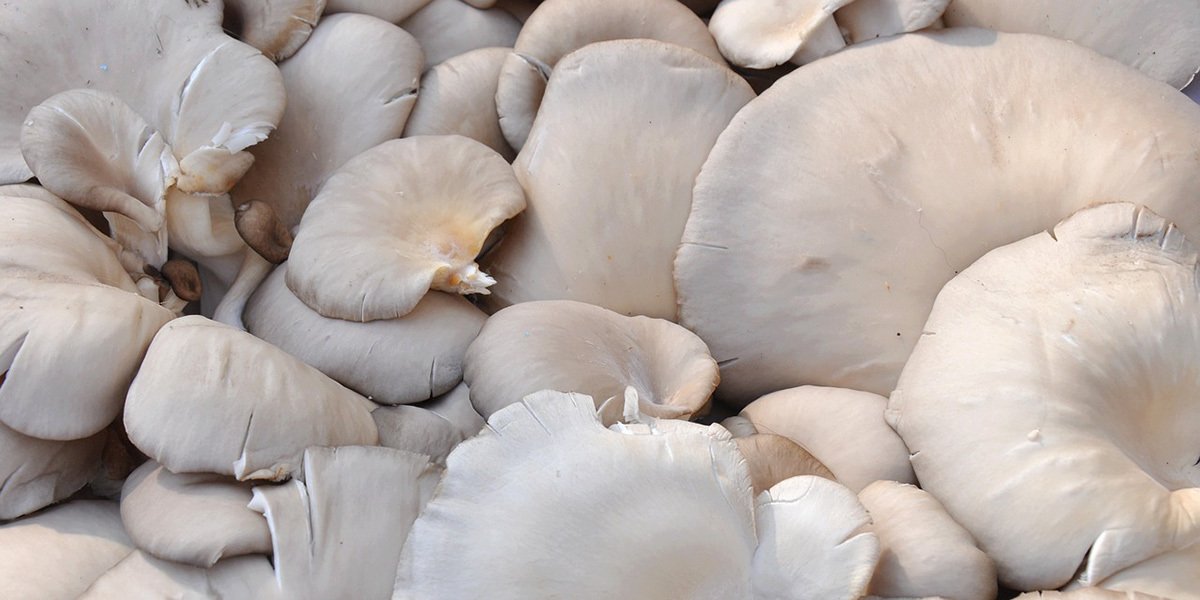
Oyster mushrooms start off with caps rolled up in a convex shape. As they mature, the caps turn up and flatten out.
Oyster mushrooms are one of the few carnivorous mushrooms! The mycelia of oyster mushrooms will kill and eat bacteria and tiny worms called nematodes. It’s believed this is the main way that oyster mushrooms get nitrogen.
The Latin name Pleurotus ostreatus translates as “sideways oyster.” So even the ancient Romans may have been calling them oyster mushrooms!
Oyster Mushrooms For Bioremediation

Bioremediation is using lifeforms to break down environmental pollution.
Oyster mushroom mycelium isn’t picky and will eat anything including coffee grounds, straw, wood, paper, and even petroleum products.
Oyster mushrooms eat hardwood in nature which is hard to break down. To do this, they use powerful enzymes capable of breaking down wood.
The types of carbon-hydrogen bonds found in wood are actually quite similar to those found in contaminants like pesticides and oil.
Scientists are still working on how to apply it on a large scale, but it already looks promising that mushrooms may one day be used to clean up oil spills and other polluted areas.
Oyster mushrooms are good at absorbing heavy metals like mercury out of their environment. You wouldn’t want to eat any mushrooms grown in mercury-heavy soil, but it’s a potential way to pull chemicals out of the ground.
Health Benefits of Oyster Mushrooms

Oyster mushrooms aren’t just tasty, they can be really good for you as well!
They contain antioxidants in addition to the vitamins and minerals that the human body needs.
But they also have the potential to lower cholesterol levels and slow the spread of cancer.
Oyster mushrooms contain compounds called polysaccharides that show possible anti-tumor effects. They also contain beta glucans which can help to stimulate the immune system and help fight cancer.
So far oyster mushrooms aren’t powerful enough to cure cancer on their own, but scientists may derive concentrated compounds from mushrooms to treat cancer in the coming years.
Oyster mushrooms can lower cholesterol since they contain a compound called statins. If you have high cholesterol, your doctor may have put you on a statin drug such as Lipitor. It’s good to know that oyster mushrooms are the naturally-occurring form of this compound.
Statins work to reduce the LDL or bad cholesterol in your body by signaling to your liver to remove cholesterol from the body.
The History of Oyster Mushrooms
Fresh oyster mushrooms have been commercially cultivated since the 1940s. They’re available in many markets around the world and come in all sorts of different sizes and colors.
Different types of oyster mushrooms are found around the world including in the UK and Ireland, most of mainland Europe, Asia, and parts of North America.
Oyster mushrooms were first officially documented in 1775 by Nikolaus Joseph Freiherr von Jacquin, a Dutch naturalist.
The mushroom was originally taxonomized as Agaricus ostreatus. In those times, most mushrooms with gills were lumped under the Agaricus genus.
In 1871, a German mycologist named Paul Kummer moved oyster mushrooms to their own genus called Pleurotus, which has remained the scientific name for oyster mushrooms until today.
Growing Oyster Mushrooms At Home

Oyster mushrooms are one of the simplest varieties of mushrooms to grow at home since they will grow on a wide variety of growing mediums.
- We have a whole step by step guide on growing oyster mushrooms which you can read here.
We also sell oyster mushroom kits that have already been inoculated and incubated.
And if you want to get started growing larger quantities of Oyster mushrooms, then check out our ready-to-fruit mushroom substrate.
So all you need to do is cut your kit open and mist it with water each day. Within two weeks you’ll have your own delicious oyster mushrooms.
If you want to learn more about growing mushrooms, then read these guides:
- Complete Guide To Chanterelle Mushrooms
- Complete Guide To Cremini Mushrooms
- Complete Guide To Morel Mushrooms
- Hen of The Woods (Maitake): The Ultimate Guide
- Puffball Mushrooms: The Ultimate Guide
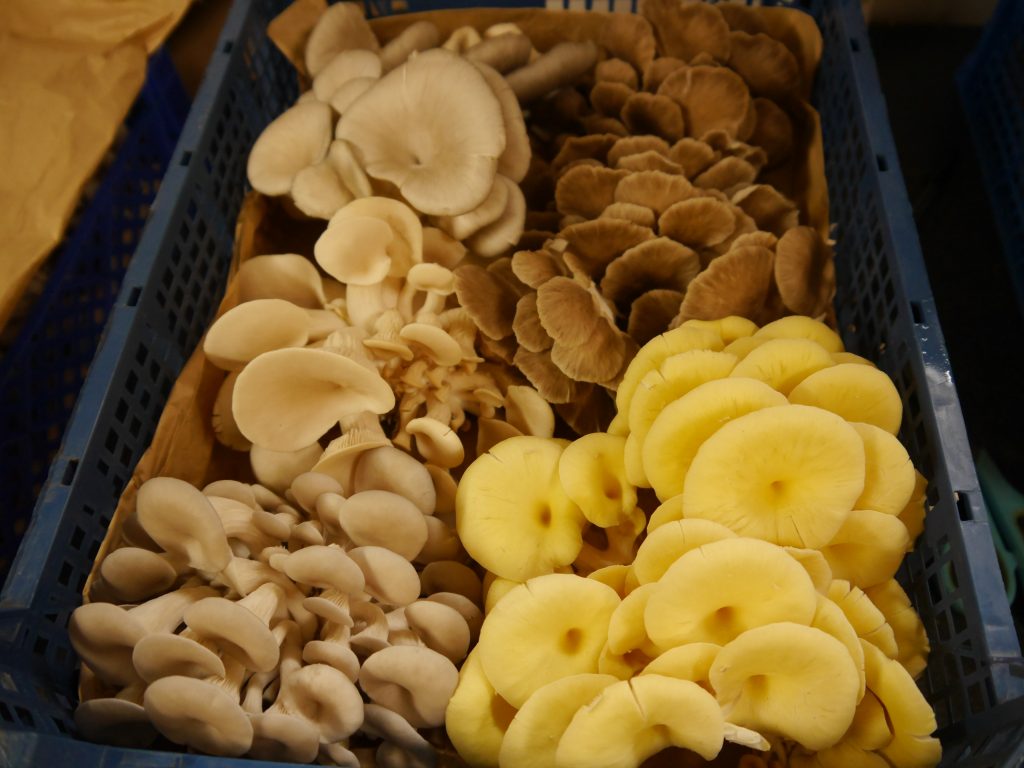
Pingback: About Oyster Mushroom - Jaylicious Food Products
Pingback: How To Create A Permaculture Orchard - GroCycle